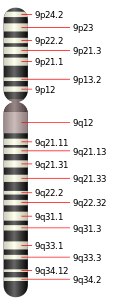Trisomy 9
| Trisomy 9 | |
|---|---|
| Classification and external resources | |
 | |
| ICD-10 | Q92 |
| ICD-9 | 758 |
| DiseasesDB | 32657 |
| MeSH | D014314 |
Trisomy 9 is a chromosomal disorder caused by having three copies (trisomy) of chromosome number 9. It can appear with or without mosaicism.
Characteristics
Symptoms vary, but usually result in dysmorphisms in the skull, nervous system, and mental retardation. Dysmorphisms in the heart, kidneys, and musculoskeletal system may also occur. An infant with complete trisomy 9 surviving 20 days after birth showed clinical features including a small face, wide fontanelle, prominent occiput, micrognathia, low set ears, upslanting palpebral fissures, high arched palate, short sternum, overlapping fingers, limited hip abduction, rocker bottom feet, heart murmurs and also a webbed neck.[1]
Trisomy 9p is one of the most frequent autosomal anomalies compatible with long survival rate. A study of 5 cases showed an association with Coffin–Siris syndrome, as well as a wide gap between the 1st and 2nd toes in all five, while three had brain malformations including dilated ventricles with hypogenesis of the corpus callosum and Dandy-Walker malformation.[2]
Detection
Trisomy 9 can be detected prenatally with chorionic villus sampling and cordocentesis, and can be suggested by obstetric ultrasonography.
Because trisomy 9 may appear with mosaicism, it is suggested that doctors take samples from multiple tissues when karyotyping for diagnosis.[3]
References
- ↑ Kannan, T. P.; Hemlatha, S.; Ankathil, R.; Zilfalil, B. A. (2009). "Clinical manifestations in trisomy 9". The Indian Journal of Pediatrics 76 (7): 745–6. doi:10.1007/s12098-009-0158-2. PMID 19475342.
- ↑ Temtamy, SA; Kamel, AK; Ismail, S; Helmy, NA; Aglan, MS; El Gammal, M; El Ruby, M; Mohamed, AM (2007). "Phenotypic and cytogenetic spectrum of 9p trisomy". Genetic counseling 18 (1): 29–48. PMID 17515299.
- ↑ Stipoljev, F.; Kos, M.; Kos, M.; Miskovi, B.; Matijevic, R.; Hafner, T.; Kurjak, A. (2003). "Antenatal detection of mosaic trisomy 9 by ultrasound: A case report and literature review". The Journal of Maternal-Fetal & Neonatal Medicine 14 (1): 65–9. doi:10.1080/713605935. PMID 14563095.
External links
- NORD - National Organization for Rare Disorders, Inc. Chromosome 9, Trisomy 9p (Multiple Variants)
- NORD - National Organization for Rare Disorders, Inc. Chromosome 9, Trisomy Mosaic
- MaggiBlair.com Maggi Blair - Trisomy 9 Mosaic Syndrome
- TRISOMY 9p / Mosaic Trisomy 9 / Trisomy 9 duplication / chromosome 9 / Survey on Trisomy 9*[http://www.trisomy9.org]